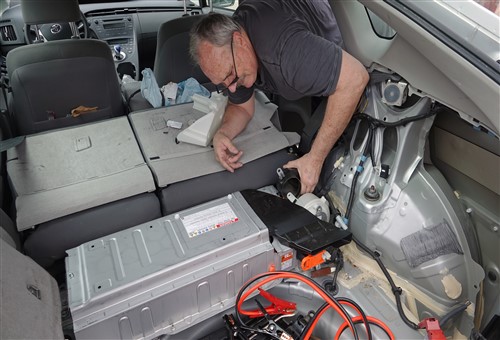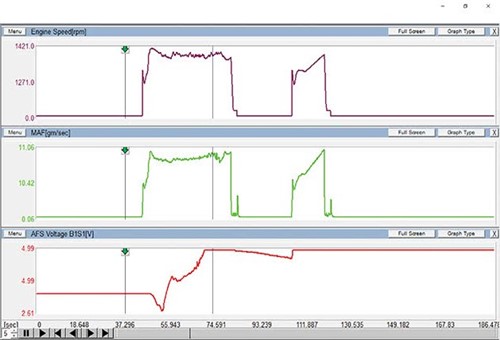
In Part 1 of this two-part article, we discussed some general aspects and features of no-crank conditions on Toyota hybrid vehicles. Now, in Part 2, we will discuss the specifics of this condition in terms of how to diagnose and resolve no-crank conditions on Toyota hybrid vehicles. Let us start with-

Image source: https://automotivetechinfo.com/wp-content/uploads/2022/01/15-percent-state-of-charge.jpg
This image shows actual freeze frame data taken from a Toyota Prius with a no-crank condition, and although there is some useful information here, the most important piece of data shown here is the high-voltage battery pack’s state of charge. At a 15.5 per cent state of charge, the battery may or may not allow one more cranking event, but that is secondary to the fact that it is unlikely that on this vehicle, there is something wrong with the high-voltage system and, in particular, with the motor/generator that cranks the engine.
In cases like this, it is likely that the vehicle’s owner merely kept on cranking the non-starting engine repeatedly until the high-voltage battery's management system intervened to protect the battery. If, on the other hand, the battery's state of charge was say, 60 per cent, but the engine would not crank, the fault is almost certainly in the high-voltage system. Bear in mind that this system is off-limits to everyone except properly trained and certified technicians.
Nonetheless, the above distinction is an important one because the processes involved in diagnosing no-start conditions on hybrid vehicles are similar to those we'd use on conventional vehicles. However, there is one important difference, this being that the freeze frame data shown here is not generated when a) the engine dies, or b) when the engine won't start again. This data is generated when the high-voltage battery's state of charge drops to the point where the battery’s management system intervenes to prevent further attempts to crank the engine.
So, in practice, freeze frame data that shows a low state of charge virtually eliminates the entire high-voltage system as the cause of the no-crank condition, which simplifies the diagnostic process. In fact, analyzing all available freeze frame data on post-2003 Toyota hybrids will usually get you to at least 90 per cent of an accurate diagnosis, but more importantly, analyzing freeze frame data before you attempt to start the vehicle will preserve the only restarting attempt you might have available before you’d have to recharge the high-voltage battery, which raises the question of-

Image source: https://automotivetechinfo.com/wp-content/uploads/2022/01/ECM-live-data-Prius-no-start.jpg
These actual waveforms were taken from a Toyota Camry with a crank-no-start condition. In this case, the waveforms were taken during the last remaining cranking event to corroborate the available freeze frame data, which, among other things, indicated an excessively lean condition.
In case you were not aware, Toyota hybrids start in closed-loop operation, and if everything works as it should, the (upstream) air/fuel ratio sensor, which has an operating range of 0.1V to about 4.99V, will generate a signal voltage of around 3.3V if the air/fuel mixture is at a stoichiometric value, which means that it consists of one part of fuel for every 14.7 parts of air.
If the mixture is leaner than stoichiometric, the signal voltage will be higher than 3.3V, and if the mixture is richer than stoichiometric, the signal voltage will be less than 3.3V. In the image shown above, the red trace represents the upstream air/fuel sensor's signal voltage output. Note that the voltage rises rapidly soon after the engine begins to crank and reaches and maintains a level of 4.99V during the whole cranking event. Therefore, in this case, the scope trace confirmed the freeze frame data; the air/fuel mixture was not only very lean- there was, in fact, no fuel present.
In this case, the vehicle had run out of fuel, which, with hybrids of all makes, happens more often than you might have thought possible, so filling the fuel tank resolved this particular crank-no-start condition.
When you are dealing with Toyota hybrids that won't crank or start, it helps to remember that the engines in hybrids need the same things that engines in conventional vehicles need to start and run. All internal combustion engines need correct valve and ignition timing, fuel, air, sufficient cylinder compression, and an ignition source at the right time to start and run but if one were to rank these factors in their order of importance, air/fuel mixture issues seem to be the most common on all internal combustion engines.
In practice, this means that on Toyota hybrids, it is possible to confirm or eliminate air/fuel mixture issues simply by looking at freeze frame data and without having to start the engine at that, which brings us to-
Old technicians often teach young mechanics that the volume of air, measured in grams per second, that enters a naturally aspirated engine should always be roughly equal to that engine's displacement, measured in litres. Thus, a 1.6L engine should use roughly 1.6 grams of air per second when it runs at about its idling speed.
However, the problem with this rule is that it assumes the vehicle is at sea level and that the engine idles at around 700 RPM. Therefore, this rule does not apply to engines in hybrid vehicles that crank at 1200 RPM.
So how do you know how much air the engine in a Toyota hybrid should ingest? Sadly, you don’t know because there are no published guidelines or specs, so like so many other things in the car repair trade, you need to learn to “know” how much air the engine needs to run efficiently. One reasonably accurate workaround is to check the air/fuel ration sensor's output voltage; if it remains steady at around 3.3 volts with the engine running, the air/fuel mixture is fine, but this is only true if the fuel pressure is within specs and no injectors are leaking, clogged, or defective in other ways. One other way is to build your own database by recording the MAF sensor readings of all the Toyota hybrids that pass through your workshop.
Nonetheless, most mechanics with experience on Toyota hybrids seem to agree that the MAF sensor on a 1.5L Prius 1NZ-FXE will record an airflow rate of between 5-8 grams per second while the engine cranks at 1200 RPM. Therefore, if the MAF records an airflow rate of say, 2.4 grams per second and an air/fuel ratio sensor signal voltage of say, 4.90V, it is almost certain that the MAF sensor is defective. Note, though, that the values used here are just examples, so use your best judgment when you assess the relationship between airflow rates and air/fuel ratio sensor output voltages on Toyota hybrids.
Note also that on 2000 to 2003 Prius models, and then again, on Prius models from 2004 to 2006, the MAF sensor was located in the air filter box directly below the air filter element. This often caused debris from the air filter box to drop into the MAF during air filter replacements. Therefore, be sure to check the model year on these Prius models before condemning an MAF sensor out of hand, which brings us to-
Many of us have (on occasion) spent significant amounts of time hunting down the cause of no-start conditions on conventional vehicles, only to discover that the fuel tank was empty. Based on this, trouble code P3193 is perhaps the most helpful trouble code Toyota has ever devised because its presence on a non-cranking, non-starting hybrid can save you hours of wasted diagnostic time.
Put simply, code P3193 will only be set if three things are true: if the air/fuel ratio sensor's output voltage shows a lean condition, the fuel level is below a specified level, and the engine does not start, one or more control modules will set code P3193 – "Fuel Run Out". This code is resolved simply by increasing the fuel level in the tank, so checking for the presence of this code early on in the process of diagnosing a no-start condition can save you a lot of time and effort, which brings us to our last point, which is that-
Although the causes of many, if not most cases of no-crank or no-start conditions on Toyota hybrids can be found in freeze frame data, the same things that cause no-start conditions on conventional vehicles also cause no-start conditions on hybrids. After all, there is nothing special about the engines in hybrids; they are just like any other internal combustion engines, so if the engine in a hybrid won't start, you would diagnose the cause(s) just as you would on any other engine.
The same usual suspects-intake airflow rates, fuel pressure, cylinder compression, valve and ignition timing, camshaft/crankshaft correlation, and spark plug condition cause the same kinds of issues they do on conventional vehicles. Misfires, increased fuel consumption, poor performance, and rough running are not only as common on hybrids as they are on conventional vehicles; these kinds of issues are also investigated, diagnosed, and resolved in the same way they are on conventional vehicles.
In fact, if we exclude and avoid the high-voltage systems on Toyota hybrids, these vehicles should not hold any terrors for any competent mechanic working in the independent car repair industry today, so are you ready to get stuck into hybrids?